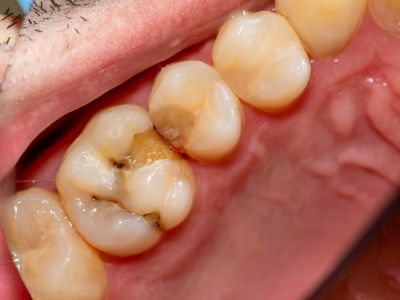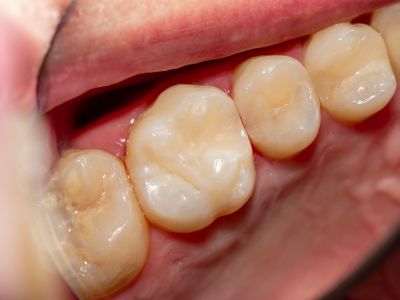Dental Restorations Part 4: Composite


In the newest generation of technology, the resin-based composite has emerged, which has replaced traditional amalgam and gold direct restorations in many cases. A composite has a resin matrix filled with various materials which can include silica, glass, or other ceramic particles. This allows for the tooth-colored appearance. Multiple variations of this design have branched, including resin modified glass ionomers (RMGIs) and giomers. Because of their more limited use, I will limit the discussion to the more common resin-based composites.
The primary indication for tooth-colored composites is to achieve a tooth-colored result, and to be able to place a filling that in some cases can be more conservative than metal alternatives. Originally, composites were limited to the front teeth, as earlier designs were not capable of withstanding the forces needed for chewing in the back. This was a massive improvement in what had otherwise required a metal crown coated with ceramic to achieve a tooth-colored result on front teeth.
For the more force-bearing and difficult-to-manage teeth in the back, amalgam and gold restorations remained desirable. As time went by, innovation allowed the composite to be feasible in almost any area. With trends today directing towards tooth-colored restorations, it is important to remember that front teeth are important for esthetics, while back teeth are important for function, and these circumstances influence the lifespan of composites, which are more sensitive to intraoral conditions and can be affected by more variables.
Composite restorations require meticulous conditions to be placed and maintained. The dentist keeps diligent isolation to repel moisture, places an etching agent to further condition the tooth surface, and then a priming agent, and a bonding agent. The material is then light cured, often with incremental buildups, and repeated light curing.
As a result, composites are retained in the tooth by bonding ("glued in") alone, rather than mechanics or suction - which means they can only last as long as the bond/glue does. Composites also shrink a small amount once set. If placed in too large a bulk, the shrinkage will be greater and exert more stress on the tooth and the bond. When the tooth naturally flexes during function, additional stresses are applied. Additionally, a sticky, thin film forms on the outer layer after light curing. It usually can be polished away, or prevented with a surface gel. If not removed, it leads to an inferior bond to the outer surface of the tooth, resulting in future microleakage, staining, and early failure of the restoration.
Acidity levels in the mouth also affect composites. If acid is present, such as from citrus juices, coffee, stomach acid, or acid from plaque, the bond and the outer surface of the composite will risk deteriorating. Acidity also makes the composite surface porous, and increasingly prone to abrasion and swelling. These factors can cause the composite's lifespan to be shortened.
Small composites confined to the exterior enamel of a tooth have the ability to last the longest. This is because pure enamel is a non-living exterior layer of the tooth. Underneath the enamel, where most fillings extend, is a different hard tissue called dentin. Dentin is a living tissue that is hydrated, houses extensions of the tooth's nerve, and has fluid and enzymes. These enzymes digest the bonding agent that hold a composite in place. It takes a long time, with many composites reaching 10 years of service or more, but this ultimately will cause the composite to debond, or "come unglued" and pop out of the tooth. The longest lasting bonded restorations that achieve 15 years or more tend to be those limited to the outer area of the tooth, or those on the front teeth where they are subjected to fewer chewing forces.
The benefit of composites is they offer a tremendous amount of esthetic potential, while also functioning quite well. Their long-term results are acceptable to many. When it comes to the appearance of a smile and maintaining the color of natural teeth, particularly those in the front of the mouth, these restorations are superior.
